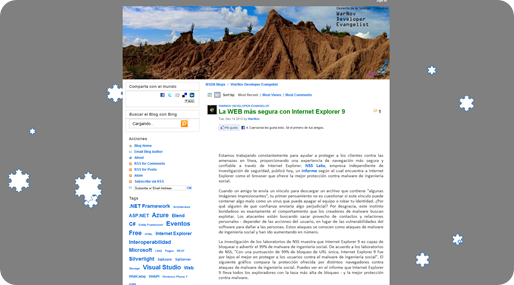Efecto Navideño para blogs usando HTML5
Luego de implementar el citado evento en mi propio blog, he recibido muchas preguntas de cómo lo logré.
He aquí la respuesta:
Este trabajo es basado en un algoritmo de Javascript para HTML5 creado por David Flanagan que se basa en generar un elemento canvas por cada copito de nieve bajando en el blog. Entonces cada copo de nieve se agrega al DOM y es animado usando posicionamiento a través de CSS. Sin embargo se puede mejor usar un solo canvas y animar los copos dentro de este tal como lo sugiere Giorgo Sardo, con el fin de ahorrar memoria. Esto sin embargo puede producir que se bloquee la interacción normal con la página… es así que lo mejor es poner el canvas en un background de menor prioridad (atrás del contenido) tal como lo pueden ver en mi blog.
Este es el JavaScript requerido:
(function () { // Start Animation only if browser support <canvas> if (document.createElement('canvas').getContext) { if (document.readyState === 'complete') Snow(); else window.addEventListener('DOMContentLoaded', Snow, false); } var deg = Math.PI / 180; //Degrees to radians var sqrt3_2 = Math.sqrt(3) / 2; //Height of an eq triangle var flakes = []; // Things that are dropping var scrollspeed = 64; // How often we animate things var snowspeed = 500; // How often we add a new snowflake var maxflakes = 20;//Max number of flakes to be added var rand = function (n) { return Math.floor(n * Math.random()); } var canvas, sky; var snowingTimer; var invalidateMeasure = false; function Snow() { canvas = document.createElement('canvas'); canvas.style.position = 'fixed'; canvas.style.top = '0px'; canvas.style.left = '0px'; canvas.style.zIndex = '0'; document.body.insertBefore(canvas, document.body.firstChild); sky = canvas.getContext('2d'); ResetCanvas(); snowingTimer = setInterval(createSnowflake,snowspeed); setInterval(moveSnowflakes, scrollspeed); window.addEventListener('resize', ResetCanvas, false); } function ResetCanvas() { invalidateMeasure = true; canvas.width = document.body.offsetWidth; canvas.height = window.innerHeight; sky.strokeStyle = '#0066CC'; sky.fillStyle = 'white'; } function drawFlake(x, y, size, order) { sky.save(); sky.translate(x, y); snowflake(order, 0, Math.floor(sqrt3_2 * y), size); sky.fill(); sky.stroke(); sky.restore(); } function snowflake(n, x, y, len) { sky.save(); // Save current transformation sky.beginPath(); sky.translate(x, y); // Translate to starting point sky.moveTo(0, 0); // Begin a new subpath there leg(n); // Draw the first leg of the fractal sky.rotate(-120 * deg); // Rotate 120 degrees anticlockwise leg(n); // Draw the second leg sky.rotate(-120 * deg); // Rotate again. leg(n); // Draw the final leg sky.closePath(); // Close the subpath sky.restore(); // Restore original transformation // Draw a single leg of a level-n Koch snowflake. // Leaves the current point at the end of // the leg it has drawn and translates the coordinate // system so the current point is (0,0). // This means you // can easily call rotate() after drawing a leg. function leg(n) { sky.save(); // Save current transform if (n == 0) { // Non-recursive case: sky.lineTo(len, 0);// Just a horizontal line } else { // Recursive case: _ _ // draw 4 sub-legs like: \/ sky.scale(1 / 3, 1 / 3); // Sub-legs are 1/3rd size leg(n - 1); // Draw the first sub-leg sky.rotate(60 * deg); // Turn 60 degrees clockwise leg(n - 1); // Draw the second sub-leg sky.rotate(-120 * deg); // Rotate 120 degrees back leg(n - 1); // Third sub-leg sky.rotate(60 * deg); // Back to original heading leg(n - 1); // Final sub-leg } sky.restore(); // Restore the transform sky.translate(len, 0);// Translate to end of leg } } function createSnowflake() { var order = 2; var size = 10 + rand(90); var t = (document.body.offsetWidth - 964) / 2; var x = (rand(2) == 0) ? rand(t) : t + 964 + rand(t); // Make it fit with my blog var y = window.pageYOffset; flakes.push({ x: x, y: y, vx: 0, vy: 3 + rand(3), size: size, order: order }); if (flakes.length > maxflakes) clearInterval(snowingTimer); } function moveSnowflakes() { sky.clearRect(0, 0, canvas.width, canvas.height); var maxy = canvas.height; for (var i = 0; i < flakes.length; i++) { var flake = flakes[i]; flake.y += flake.vy; flake.x += flake.vx; if (flake.y > maxy) flake.y = 0; if (invalidateMeasure) { var t = (canvas.width - 964) / 2; flake.x = (rand(2) == 0) ? rand(t) : t + 964 + rand(t); } drawFlake(flake.x,flake.y,flake.size,flake.order); // Sometimes change the sideways velocity if (rand(4) == 1) flake.vx += (rand(11) - 5) / 10; if (flake.vx > 2) flake.vx = 2; if (flake.vx < -2) flake.vx = -2; } if (invalidateMeasure) invalidateMeasure = false; } }());
Felices fiestas!
snowflake, snow effect, JavaScript, html5, css, canvas, animation, christmas, blog
Comments
- Anonymous
December 17, 2010
The comment has been removed - Anonymous
December 13, 2012
WTF, me clonaron :) - de hecho a mi me gusta el efecto
